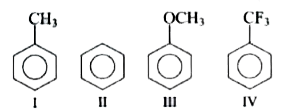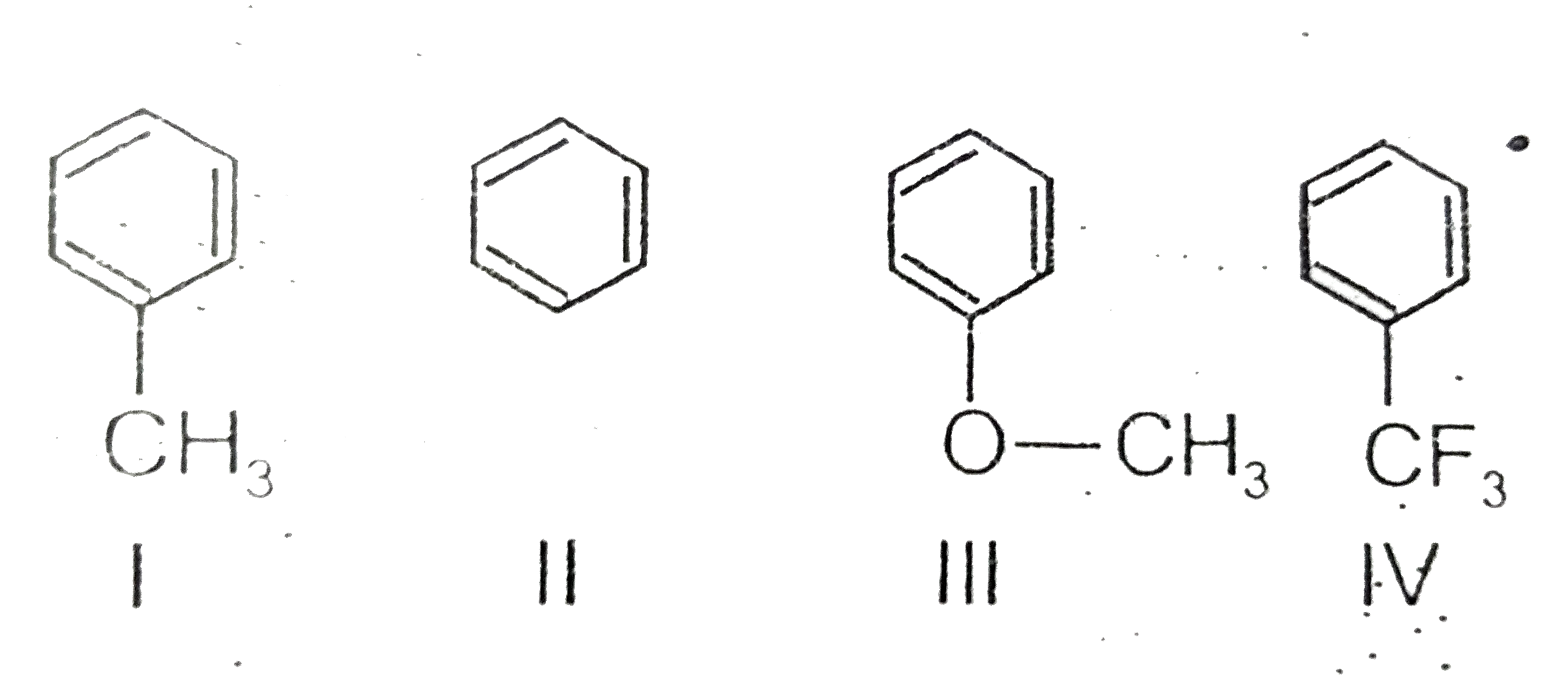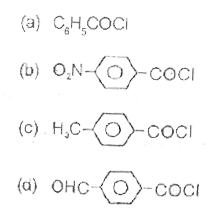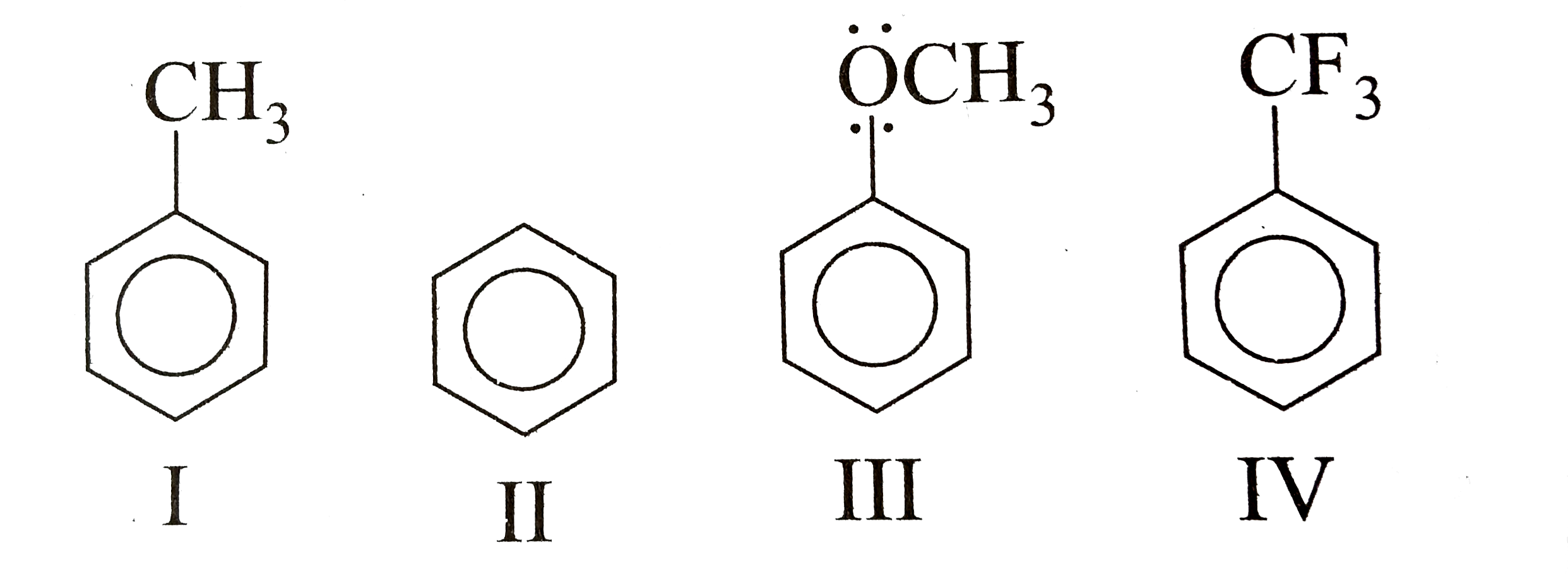Which of the following compounds are not arranged in order of decreasing reactivity towards electrophilic substitution
Fluoro benzene > chloro benzene > bromo benzene
Phenol > n-propyl benzene > benzoic acid
Chloro toluene > para-nitro toluene > 2-chloro-4-nitro toluene
Benzoic acid > phenol > n-propyl benzene
The correct Answer is:D
To solve the question regarding the order of decreasing reactivity towards electrophilic substitution, we will analyze the given compounds based on their substituents and their effects on the electron density of the benzene ring.
1. Understand Electrophilic Substitution:
- Electrophilic substitution reactions in aromatic compounds depend on the electron density of the benzene ring. More electron density means higher reactivity towards electrophiles.
2. Identify the Compounds:
- The compounds to analyze are:
1. Fluorobenzene
2. Chlorobenzene
3. Bromobenzene
4. Phenol
5. n-Propylbenzene
6. Benzoic acid
7. Chlorotoluene
8. Para-nitrotoluene
9. 2-Chloro-4-nitrotoluene
3. Analyze the Effects of Substituents:
- Fluorobenzene: Fluorine is highly electronegative and has a strong -I (inductive) effect, which decreases electron density. Thus, it is the least reactive.
- Chlorobenzene: Chlorine is also -I but less than fluorine, making it more reactive than fluorobenzene but still less than other electron-donating groups.
- Bromobenzene: Bromine is less electronegative than chlorine, so it has a weaker -I effect, making it more reactive than both fluorobenzene and chlorobenzene.
- Phenol: The hydroxyl group (-OH) has a +R (resonance) effect, which increases electron density, making phenol highly reactive.
- n-Propylbenzene: The n-propyl group also has a +I effect, increasing electron density, but not as strongly as phenol.
- Benzoic Acid: The carboxylic acid group (-COOH) has a -R effect, which decreases electron density, making benzoic acid the least reactive among these.
- Chlorotoluene: The methyl group (+I) increases reactivity, but chlorine (-I) decreases it. The overall effect is moderate.
- Para-nitrotoluene: The nitro group (-NO2) is a strong -I and -R group, which decreases reactivity significantly.
- 2-Chloro-4-nitrotoluene: Similar to para-nitrotoluene, but with an additional chlorine, further decreasing reactivity.
4. Determine the Correct Order:
- Based on the analysis:
- Reactivity order from highest to lowest:
- Phenol > n-Propylbenzene > Bromobenzene > Chlorobenzene > Fluorobenzene > Chlorotoluene > Para-nitrotoluene > 2-Chloro-4-nitrotoluene > Benzoic Acid.
5. Identify Incorrect Arrangements:
- The question asks for the compounds that are not arranged in the correct order of decreasing reactivity.
- Based on the analysis, we can conclude that:
- Fluorobenzene should be the least reactive, and benzoic acid should be at the bottom due to its -R effect.
- Therefore, options involving benzoic acid being more reactive than phenol or chlorobenzene being more reactive than nitro compounds are incorrect.
Conclusion:
The compounds that are not arranged in order of decreasing reactivity towards electrophilic substitution are Fluorobenzene and Benzoic Acid when compared to Phenol and Chlorobenzene.
- Electrophilic substitution reactions in aromatic compounds depend on the electron density of the benzene ring. More electron density means higher reactivity towards electrophiles.
- The compounds to analyze are:
1. Fluorobenzene
2. Chlorobenzene
3. Bromobenzene
4. Phenol
5. n-Propylbenzene
6. Benzoic acid
7. Chlorotoluene
8. Para-nitrotoluene
9. 2-Chloro-4-nitrotoluene
- Fluorobenzene: Fluorine is highly electronegative and has a strong -I (inductive) effect, which decreases electron density. Thus, it is the least reactive.
- Chlorobenzene: Chlorine is also -I but less than fluorine, making it more reactive than fluorobenzene but still less than other electron-donating groups.
- Bromobenzene: Bromine is less electronegative than chlorine, so it has a weaker -I effect, making it more reactive than both fluorobenzene and chlorobenzene.
- Phenol: The hydroxyl group (-OH) has a +R (resonance) effect, which increases electron density, making phenol highly reactive.
- n-Propylbenzene: The n-propyl group also has a +I effect, increasing electron density, but not as strongly as phenol.
- Benzoic Acid: The carboxylic acid group (-COOH) has a -R effect, which decreases electron density, making benzoic acid the least reactive among these.
- Chlorotoluene: The methyl group (+I) increases reactivity, but chlorine (-I) decreases it. The overall effect is moderate.
- Para-nitrotoluene: The nitro group (-NO2) is a strong -I and -R group, which decreases reactivity significantly.
- 2-Chloro-4-nitrotoluene: Similar to para-nitrotoluene, but with an additional chlorine, further decreasing reactivity.
- Based on the analysis:
- Reactivity order from highest to lowest:
- Phenol > n-Propylbenzene > Bromobenzene > Chlorobenzene > Fluorobenzene > Chlorotoluene > Para-nitrotoluene > 2-Chloro-4-nitrotoluene > Benzoic Acid.
- The question asks for the compounds that are not arranged in the correct order of decreasing reactivity.
- Based on the analysis, we can conclude that:
- Fluorobenzene should be the least reactive, and benzoic acid should be at the bottom due to its -R effect.
- Therefore, options involving benzoic acid being more reactive than phenol or chlorobenzene being more reactive than nitro compounds are incorrect.
The compounds that are not arranged in order of decreasing reactivity towards electrophilic substitution are Fluorobenzene and Benzoic Acid when compared to Phenol and Chlorobenzene.
Similar Questions
Knowledge Check
Among the compounds the order of decreasing reactivity towards electrophilic substitution is :
 AII>I>III>IVBIII>I>II>IVCIIIgI>IV>IIDII>I>IV>III
AII>I>III>IVBIII>I>II>IVCIIIgI>IV>IIDII>I>IV>IIIThe correct order of reactivity towards electrophilic substitution is
Abenzene > phenol > benzoic acid > chlorobenzeneBphenol > benzene > chlorobenzene > benzoic acidCchlorobenzene > benzoic acid > phenol > benzeneDbenzoic acid > chlorobenzene > benzenegtphenol.
Among the following compounds, the decreasing order of reactivity towards electrophilic substitution is

View SolutionArrange the following compounds in order of increasing reactivity towards nucleophilic substitution:

View SolutionArrange the following compounds in order of decreasing reactivity towards SN1 reaction

View SolutionWhich of the following metioned positons in the given compound is more reactive towards electrophilic substituations?

View SolutionRank the following compounds in decreasing order of reactivity in electrophilic aromatic substitution reaction

View SolutionConsider the following compounds

The correct decreasing order of their reactivity towards hydrolysis is
View Solution


_CHE_E06_235_Q01.png)